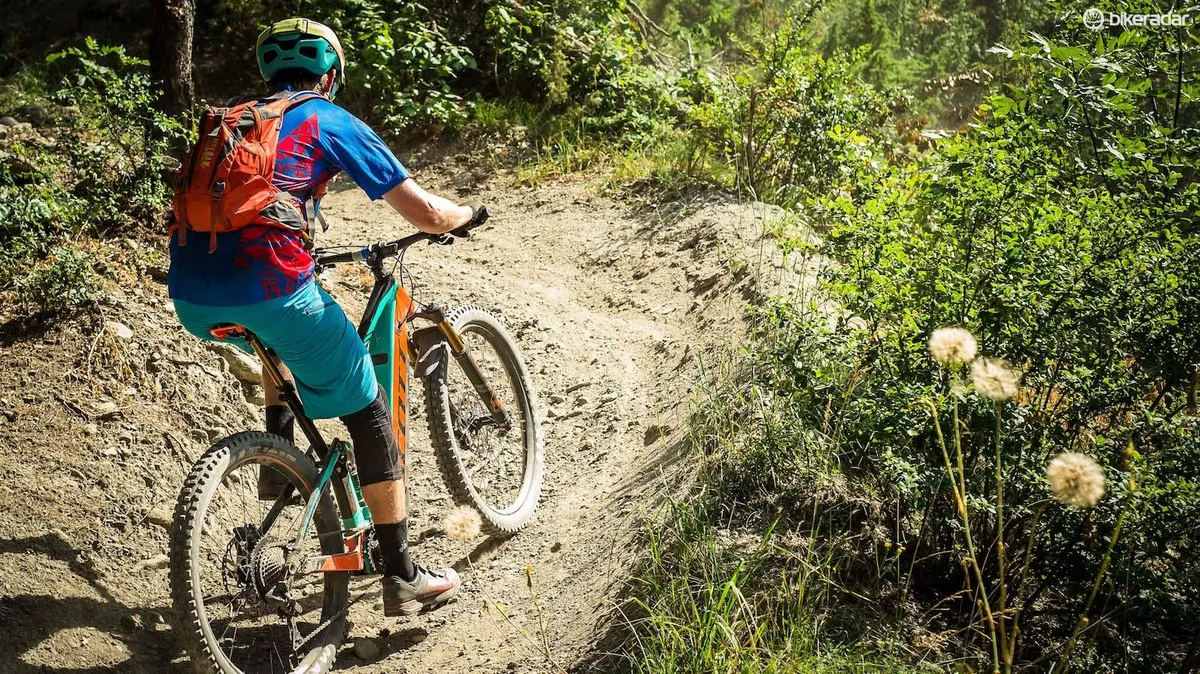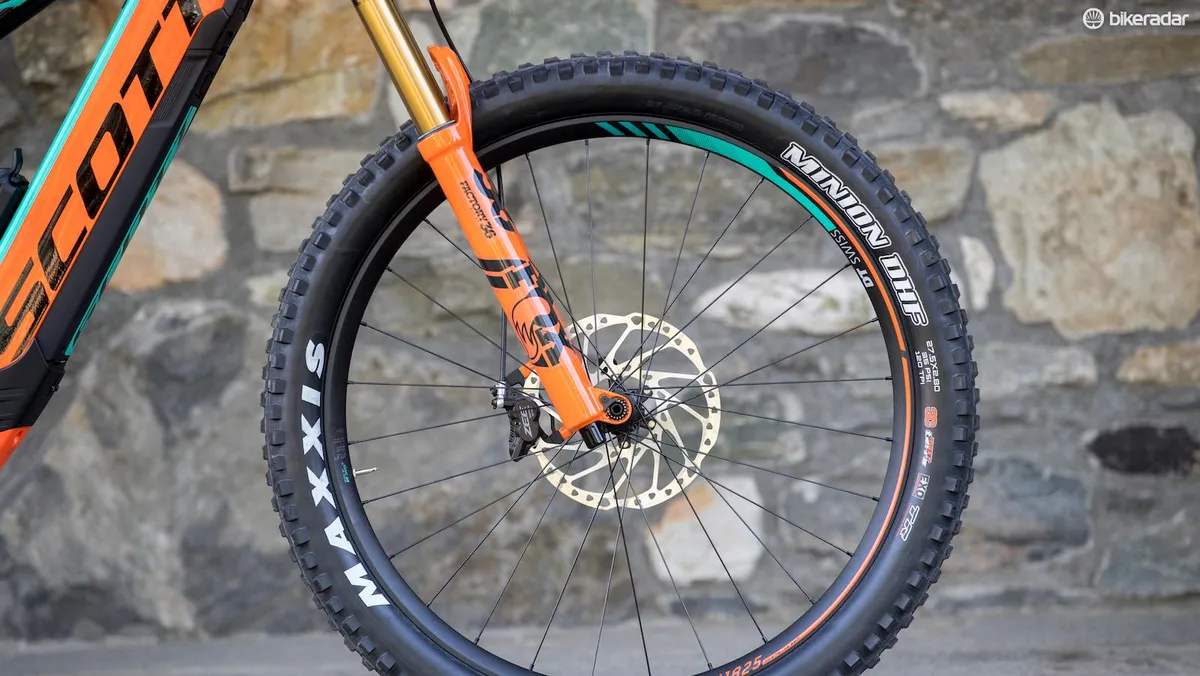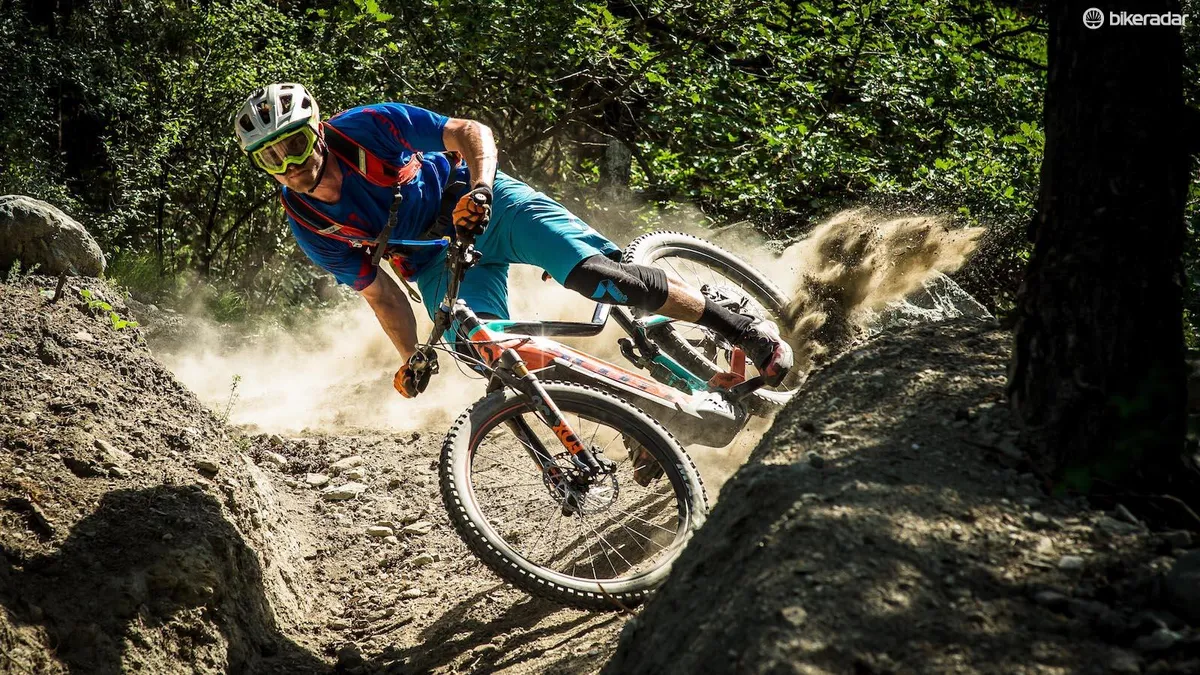Scott unveiled its new and (much) improved Genius just a few days ago, but in parallel to the quintessential trail bike, it has developed an electric version… meet the creatively titled E-Genius.
Scott E-Genius spec overview
- Frame: Alloy / Virtual 4 link kinematic VLK 27Plus and 29 compatible, Boost 148x12mm 150mm travel, Shimano E-8000 Int. DT Battery Tapered Headtube E2
- E-drive system: Shimano STEPS E8000 250W with integrated 500Wh battery
- Fork: FOX 36 Float Factory Air
- Rear shock: Fox Nude EVOL Trunnion
- Remote system: Scott TwinLoc Remote Technology with three modes front and rear
- Headset: Syncros FL1.5 Press Fit E2
- Rear derailleur: Shimano XT RD-M8050-Di2 SGS DM 11-speed
- Front derailleur: Scott Chainguide
- Shifters: Shimano XT SW-M8050-R
- Brakes: Shimano BR-M640 ZEE Disc
- Crankset: Shimano STEPS FC-E8050 34T
- Handlebar: Syncros FL1.0 Di2 mini riser
- Stem: Syncros FL1.5
- Seatpost: FOX Transfer dropper remote
- Chain: Shimano CN-HG601
- Cassette: Shimano XT CS-M8000 11-46t
- Tyres: Maxxis Minion DHF (front) Maxxis Minion DHR II (rear)
- Wheelset: DT Swiss H1825 Spline CL
E-bike vs. non e-Bike: what’s the difference?

Like the non-electric version, it uses a Horst-link suspension system, driving a vertically aligned, Trunnion-mounted shock.
The suspension kinematic is very similar to the standard Genius, which means a genuinely progressive and pedal-efficient action, delivering 150mm of travel front and rear.
The geometry is pretty similar too. It’s equally slack, with a 65-degree head angle in the low setting. The Reach numbers are slightly shorter on paper, but this is due to longer head tubes and higher stack height.
The front centre is virtually identical on both bikes, so if you set your bars to the same height on each bike, the effective reach will be about the same. Still, the on-paper reach figure is nice and roomy at 443mm for the Medium and 490mm in XL.
The bottom bracket (BB) height remains nice and low too, with only 3mm less BB drop than the standard Genius. I measured my test bike’s BB height at 336mm in the high setting with 27.5” x 2.8” Maxxis tyres. That’s really low for an e-bike, they tend to have higher BBs to avoid pedal-strikes.

The only real geometry difference between the Genius and E-Genius is the chainstay length.
Scott proudly claims that the new E-Genius’ chainstay is 30mm shorter than its predecessor, at 460mm. That compares to 436mm on the standard Genius.
Scott seemed almost apologetic that it’s not even shorter. I actually measured my bike’s back end at 465mm — maybe Scott’s tape measure is different to mine. Personally though, I think the E-bike’s chainstay length is bob-on. More on that later.
The E-genius is only available in aluminium — what’s the point of carbon when you’ve got several kilos of electronics on board? I weighed my XL test bike on my own scales at 23.2kg without pedals, which is pretty average for a full-sus e-bike.
Electric energy
The bike uses Shimano’s superb Steps E8000 motor, along with a fully-integrated 500Wh battery which slots easily into the down tube.
For those unfamiliar with e-bikes, ‘Wh’ stands for Watt hours, and is a measurement of the electrical energy the battery can hold. 500Wh is pretty average for an e-MTB battery, some have a little more, some a little less.
To put that into context, using the motor’s ‘Trail’ mode (there’s also an Eco mode and a Boost mode for steep climbs or when you’re feeling lazy), I managed around 1,200m of fast tarmac climbing before the battery was nearly spent and I had to turn around. You could eek it out a bit further if you ran it in Eco mode, though.
The ride

Now, Scott gets a lot of kudos from me for being bold with its push towards genuinely long, low and slack geometry, but with the standard Genius I struggled with the low bar height and the short chainstay length. Together, they made it hard for me to keep pressure on the front tyre.
The E-Genius has no such problem. The maximum bar height on my XL was around 109cm — that’s really tall. This helped me feel far more confident attacking steep and loose descents, and also makes it that much easier to manual and lift the front end.
The ride is utterly planted, even in the comically dusty, loose and rocky terrain
Despite the fairly long (though pretty average for an e-bike) chainstay length, I had no problem holding a manual on my XL, although it does take quite a lot more muscle to get that heavy front end airborne.
The 1,300mm wheelbase and 465mm rear-centre on the XL resulted in a superb weight distribution. Combined with the super grippy 2.8” Maxxis Minion tyres, this made the E-Genius an absolute riot in the tight and dusty corners of Aosta and Pila, Italy.
The slack head angle and low bottom bracket (I ran it in the low setting most of the time) makes it feel super safe and planted in the steep, rough terrain too.
You may think safe is boring, but for me, that feeling of confidence and stability simply means I charge harder and faster before reaching my bravery threshold.
I spent some time alternating between the Genius and the E-Genius, and under this back-to-back comparison I felt far more confident on the electric bike, which allowed me to ride more aggressively and get looser in the turns. As far as I’m concerned, safe is fun.
The grippier tyres, longer chainstay and higher bar height are certainly part of this, but the extra sprung mass is the elephant in the room. To learn more about sprung and unsprung weight, have a look at the video below.
Our tester extraordinaire Seb Stott takes a closer look at whether or not lighter bikes are truly faster for downhill riding
That extra frame weight makes the already supple suspension feel even more sensitive, and the already superb tyres grip even harder. The ride is utterly planted, even in the comically dusty, loose and rocky terrain of Pila.
This is helped by the dialled suspension. As with the regular Genius, it’s supple off the top, but the support builds gradually through the stroke. The progression is also superbly well-balanced against the fork from the off. The E-Genius also gets Fox’s e-bike specific fork, which I think is noticeably more active under braking due to the stiffer chassis, which binds less under braking forces.

When climbing, I found the normal Genius a little hard to manage due to the fairly slack (by modern trail bike standards) seat angle and short chainstays. They made it difficult to keep the front end from going light in steep terrain.
With the E-Genius, of course, the motor makes things much easier — that’s a given — but the longer chainstay helps too. It keeps the weight more central, preventing the front end from lifting so easily on steep climbs. In fact, thanks to the smooth power delivery from the Shimano Steps motor, and the paddle-like tread of the Minion DHR2 rear tyre, the E-Genius had me scaling steep, dusty chutes that I was convinced would make it come unstuck.
Things that could be improved
There were a couple of things I didn’t like about the E-Genius, though.
I’m a big fan of the low bottom bracket for descending, and when climbing I didn’t actually clip pedals that often thanks to the high degree of mid-stroke support from the suspension. Even so, I’d rather see a shorter crank arm than the 175mm items stocked just to make clearance that much better.
The benefits of long crank arms on mountain bikes are questionable at best, and the extra oomph of an e-bike makes any efficiency gains pretty much irrelevant, so you may as well have the extra pedal-clearance of a shorter arm to help you motor up the steep, rocky scrambles.
While I’m quite a big fan of Scott’s Twinlock system, I think it’s pretty unnecessary on an e-bike. The firmer spring curve of the ‘Traction’ mode was handy, but I’d happily disconnect the fork lockout cable to get more front-end traction on the climbs when using the firmer shock setting.

Also, the proprietary Fox NUDE shock seems to have larger gaps between the rebound clicks than a regular DPS. That’s fine for most people, but as a serious suspension geek, I felt my ideal setting was in-between clicks.
Worse, the extra damping energy that an e-bike puts into the shock meant it suffered from heat build-up pretty quickly on the descents. This caused the rebound speed to pick up noticeably, leading to a bucking sensation on jumps and landings. For this reason, I’d rather have a piggyback shock in there for better heat management.
The 740mm bar is simply too narrow too, and I’d have preferred even more dropper post travel.
While the tyres are superb, I can’t wait for thicker casing versions to become available to deal with the kind of rough-terrain trauma where a bike like this excels. Alternatively, it would be cool to see in-tyre inserts, such as Huck Norris or Flat Tyre Defender, installed as stock.
Overall though, Scott has pretty much nailed it with the E-Genius. The geometry, suspension, motor and tyres all work together to deliver a flat-out and confidence-inspiring riot of a ride.
I said just a few weeks ago that BMC’s Trailfox AMP was one of the best-cornering e-bikes I’ve ridden, but I have to change my mind now that I’ve ridden the E-Genius. For me, Scott’s longer, slacker geometry and far better-balanced suspension make it far more capable in my opinion.
Prices for the E-Genius are yet to be announced, but there will be four models including a women’s specific version.
Availability is expected from late September.

